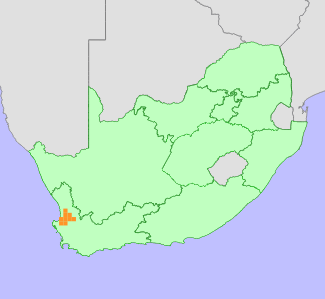|
Scientific Name | Leucadendron brunioides Meisn. var. flumenlupinum I.Williams |
Higher Classification | Dicotyledons |
Family | PROTEACEAE |
Common Names | Graafwater Conebush (e) |
National Status |
Status and Criteria | Endangered A2c; B1ab(ii,iii,iv,v)+2ab(ii,iii,iv,v); C2a(i) |
Assessment Date | 2020/05/18 |
Assessor(s) | A.G. Rebelo, H. Mtshali & L. von Staden |
Justification | Leucadendron brunioides var. flumenlupinum has a restricted distribution range, with an extent of occurrence (EOO) of 3248-3265 km², and an area of occupancy (AOO) of 216 km². The population is severely fragmented and there is continuing decline due to ongoing habitat loss and degradation. A population reduction of 48-57% over three generations is estimated from habitat loss over the past 150-300 years (generation length for this long-lived resprouter exceeds 100 years). It has a small population of 976-2680 plants. All subpopulations are small, consisting of fewer than 200 plants. |
Distribution |
Endemism | South African endemic |
Provincial distribution | Western Cape |
Range | This species is endemic in Western Cape Province of South Africa, where it occurs from Graafwater to Aurora and Eendekuil. |
Habitat and Ecology |
Major system | Terrestrial |
Major habitats | Saldanha Flats Strandveld, Graafwater Sandstone Fynbos, Hopefield Sand Fynbos, Leipoldtville Sand Fynbos |
Description | It occurs in dry montane fynbos in moist habitats such as seeps and river courses on sandy alluvium or sandstone-derived soils. It is a long-lived taxon, and survives fires by resprouting from underground boles or rootstocks. Wind-dispersed seeds are released after ripening, and is stored in surface leaf-litter. It is dioecious, with insect-pollinated male and female flowers occurring on separate plants. |
Threats |
| The main threat to this taxon's is habitat loss to agricultural expansion, predominantly rapidly expanding cultivation of the Leipoldtville, Hopefield and Graafwater Sandstone Fynbos, and Saldanha Flats Strandveld for potatoes, onions, rooibos tea and pasture for livestock. About 56% of its habitat is already irreversibly modified, and loss continues with 12% of loss taking place between 1990 and 2014.
Plants remain in small fragments of natural vegetation, and these fragments are being degraded by inappropriate fire management and competition from unmanaged invasive alien plants, mainly acacia species.
Modelling of habitat loss in combination with climate change predicted that this species could decline by more than 80% by 2025 (Bomhard et al. 2005). This analysis however did not consider that this species is a very long-lived resprouter, and is therefore likely to persist, even though climate change may limit recruitment. Ongoing monitoring is needed, particularly as droughts in the Western Cape increase pressure on groundwater resources, on which this seep-preferring species is dependent. Additional threats include groundwater extractions and pollution (eutrophication) of groundwater and watercourses. |
Population |
This taxon was known historically from only a small area around Graafwater, major range extensions (from a range of 10 to well over 80 km) were discovered by citizen scientists working on the Protea Atlas Project between 1992 and 2002. Currently, this taxon is quite rare, and more than 50% subpopulations are small and fragmented the majority occurring either in road verges or adjacent to farmland. It is estimated that the population consists of fewer than 2500 mature individuals and that no subpopulation has more than 250 mature individuals. The population continues to decline due to habitat loss and degradation. Monitoring is needed, particularly for subpopulations that occur in seeps as it is likely to be sensitive to drought and groundwater extraction.
|
Population trend | Decreasing |
Conservation |
| It is not currently conserved in any formally protected area. |
Assessment History |
Taxon assessed |
Status and Criteria |
Citation/Red List version | | Leucadendron brunioides Meisn. var. flumenlupinum I.Williams | CR A3c+4c | Raimondo et al. (2009) | | Leucadendron brunioides Meisn. var. flumenlupinum I.Williams | Rare | Hilton-Taylor (1996) | | Leucadendron brunioides Meisn. var. flumenlupinum I.Williams | Rare | Hall et al. (1980) | |
Bibliography |
Bomhard, B., Richardson, D.M., Donaldson, J.S., Hughes, G.O., Midgley, G.F., Raimondo, D.C., Rebelo, A.G., Rouget, M. and Thuiller, W. 2005. Potential impacts of future land use and climate change on the Red List status of the Proteaceae in the Cape Floristic Region, South Africa. Global Change Biology 11(9):1452-1468.
Hall, A.V., De Winter, M., De Winter, B. and Van Oosterhout, S.A.M. 1980. Threatened plants of southern Africa. South African National Scienctific Programmes Report 45. CSIR, Pretoria.
Hilton-Taylor, C. 1996. Red data list of southern African plants. Strelitzia 4. South African National Botanical Institute, Pretoria.
Raimondo, D., von Staden, L., Foden, W., Victor, J.E., Helme, N.A., Turner, R.C., Kamundi, D.A. and Manyama, P.A. 2009. Red List of South African Plants. Strelitzia 25. South African National Biodiversity Institute, Pretoria.
Rebelo, T. 2001. Sasol Proteas: A field guide to the proteas of southern Africa. (2nd ed.). Fernwood Press, Vlaeberg, Cape Town.
|
Citation |
| Rebelo, A.G., Mtshali, H. & von Staden, L. 2020. Leucadendron brunioides Meisn. var. flumenlupinum I.Williams. National Assessment: Red List of South African Plants version . Accessed on 2025/08/20 |
 Comment on this assessment
Comment on this assessment

